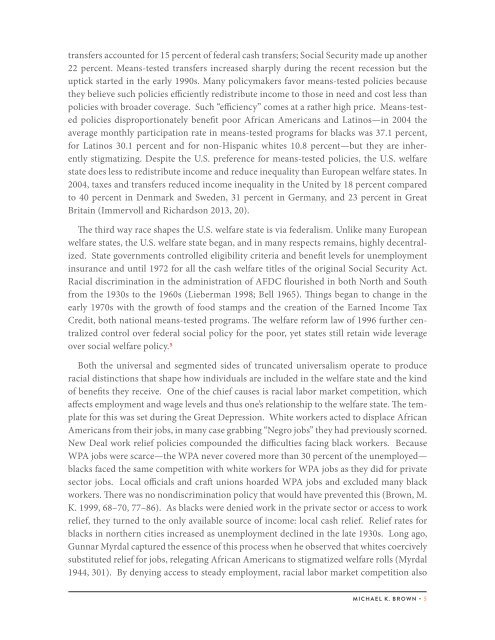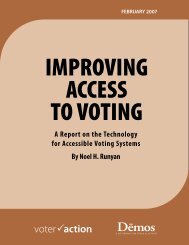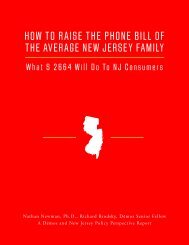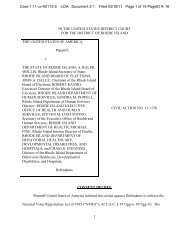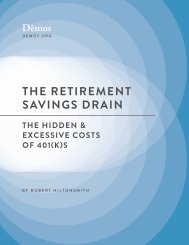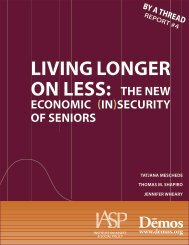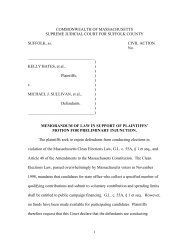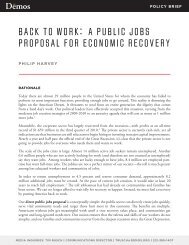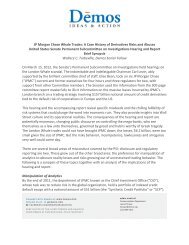The Foundations of Durable Racial Inequality, 1940-2013 - Demos
The Foundations of Durable Racial Inequality, 1940-2013 - Demos
The Foundations of Durable Racial Inequality, 1940-2013 - Demos
You also want an ePaper? Increase the reach of your titles
YUMPU automatically turns print PDFs into web optimized ePapers that Google loves.
transfers accounted for 15 percent <strong>of</strong> federal cash transfers; Social Security made up another22 percent. Means-tested transfers increased sharply during the recent recession but theuptick started in the early 1990s. Many policymakers favor means-tested policies becausethey believe such policies efficiently redistribute income to those in need and cost less thanpolicies with broader coverage. Such “efficiency” comes at a rather high price. Means-testedpolicies disproportionately benefit poor African Americans and Latinos—in 2004 theaverage monthly participation rate in means-tested programs for blacks was 37.1 percent,for Latinos 30.1 percent and for non-Hispanic whites 10.8 percent—but they are inherentlystigmatizing. Despite the U.S. preference for means-tested policies, the U.S. welfarestate does less to redistribute income and reduce inequality than European welfare states. In2004, taxes and transfers reduced income inequality in the United by 18 percent comparedto 40 percent in Denmark and Sweden, 31 percent in Germany, and 23 percent in GreatBritain (Immervoll and Richardson <strong>2013</strong>, 20).<strong>The</strong> third way race shapes the U.S. welfare state is via federalism. Unlike many Europeanwelfare states, the U.S. welfare state began, and in many respects remains, highly decentralized.State governments controlled eligibility criteria and benefit levels for unemploymentinsurance and until 1972 for all the cash welfare titles <strong>of</strong> the original Social Security Act.<strong>Racial</strong> discrimination in the administration <strong>of</strong> AFDC flourished in both North and Southfrom the 1930s to the 1960s (Lieberman 1998; Bell 1965). Things began to change in theearly 1970s with the growth <strong>of</strong> food stamps and the creation <strong>of</strong> the Earned Income TaxCredit, both national means-tested programs. <strong>The</strong> welfare reform law <strong>of</strong> 1996 further centralizedcontrol over federal social policy for the poor, yet states still retain wide leverageover social welfare policy.5Both the universal and segmented sides <strong>of</strong> truncated universalism operate to produceracial distinctions that shape how individuals are included in the welfare state and the kind<strong>of</strong> benefits they receive. One <strong>of</strong> the chief causes is racial labor market competition, whichaffects employment and wage levels and thus one’s relationship to the welfare state. <strong>The</strong> templatefor this was set during the Great Depression. White workers acted to displace AfricanAmericans from their jobs, in many case grabbing “Negro jobs” they had previously scorned.New Deal work relief policies compounded the difficulties facing black workers. BecauseWPA jobs were scarce—the WPA never covered more than 30 percent <strong>of</strong> the unemployed—blacks faced the same competition with white workers for WPA jobs as they did for privatesector jobs. Local <strong>of</strong>ficials and craft unions hoarded WPA jobs and excluded many blackworkers. <strong>The</strong>re was no nondiscrimination policy that would have prevented this (Brown, M.K. 1999, 68–70, 77–86). As blacks were denied work in the private sector or access to workrelief, they turned to the only available source <strong>of</strong> income: local cash relief. Relief rates forblacks in northern cities increased as unemployment declined in the late 1930s. Long ago,Gunnar Myrdal captured the essence <strong>of</strong> this process when he observed that whites coercivelysubstituted relief for jobs, relegating African Americans to stigmatized welfare rolls (Myrdal1944, 301). By denying access to steady employment, racial labor market competition alsoMICHAEL K. BROWN • 5


